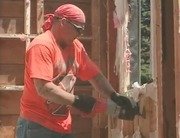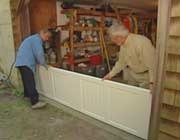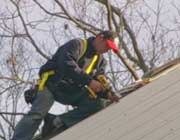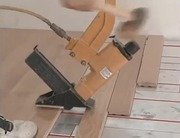Alright so Todd, just to recap what's already happened here, I mean you're the contractor, you've done this before for ten years right?
Yeah, absolutely.
So you've got a lot of experience with this.
It's like a very fast working process.
Yes, we did this.
We had the first floor walls up and I think we were in here for two days and then we had another day for staging.
Yeah, so just two concrete pours have taken place.
That got in your footing.
I got in your garage slab, the first floor walls, and the slab that we're looking at down here, right?
Right, the structural floor.
Any idea how many yards of concrete has gone into these two pours?
We're pushing seventy.
Pushing seventy.
Seventy yards, yeah.
Okay.
And of course the thing is built like a fortress.
But now what we've got is all the form work in place for the upper level as well as for this gable end wall.
Right.
Which, you know, if you think think about it, that's really amazing that you can go up this high with a gable end like this.
And all of it is just, styroform forms.
Let's review again how the forms are put together.
So the of course, there's a tooth system and they lock into each other.
Yeah.
And that, when they put the concrete on top of the web, that pinches the joint down together and makes it really tight.
It makes it a more stable form.
And the rebar is already in place in most of these areas, right?
Right, we have no-tie rebar chairs, that we just drop the rebar right through the center of the circle ties.
OK, and I just noticed that he was just passing up some more rebar, so that means that as the pour is going along, you have to insert additional pieces?
We've got, anywhere were the rebar is short, we'll put some dowels in, to make a lap splice.
This is kind of neat because it's a clear story so this side of the gable is gonna be higher than this side of the gable.
And because of the solar, he's gonna have the windows coming in on that base of the wall there that's exposed.
So what we're doing is capping off the higher end of gable end.
Exactly.
So the concrete won't flow out of there.
Exactly.
So all we need to do is put a little bit of glue on there.
Al will probably put some nails in there that tack while that glue sets and then were good to go.
You 'll be able to pour up there without any kind of, oh yeah.
He's got some wire holding it, but it's actually the glue is going to hold it together,
Because the glue minimally expanding, the ties that he is putting in basically hold the foam in place until the glue sets up.
Until the glue sets up.
This glue is definitely some powerful stuff.
Yeah, and this is the backside of the gable end, which of course is higher.
By about 3 and a half feet, then the front side in order to allow for our clear story.
glazing, which is part of the solar plan here.
Right.
So you can see we can make the foam adapt to any shape that we need to.
OK.
So, are we ready, ready to pour the concrete?
Yeah, I am.
And what you've got essentially is a big bumper truck behind us here, and where's the operator?
The operator's down here in on the deck.
There he is.
So that man over there who's got the yellow box, the control box.
He tries to stay close to me, so we both know what we're doing during the pour.
And we're going to start at the back end.
Right?
Correct.
All right, lets get started.
All right.
Keep pumping.
Good.
A little more.
Stop.
Good.
Okay, so what we're watching them do up there is, kinda like, the final step after pouring the concrete into the form work.
They've already included the threaded rod, and they've pre-drilled the top plate of the wall.
So, that basically, will be the transition.
The wooden transition from concrete to the wooden roof system and this is all about speed, so it's going very, very well.
It's week two of our project here, and we're going to spend a minute chatting with Jim Neha from the Portland Cement Association, and of course, Howard Rickman, who is our homeowner here.
But Jim, what are some of the advantages of this kind of a project, of building with concrete to this extent?
Well, building with concrete or with the insulating concrete forms, it has a lot of advantages for the builder and the homeowner.
For the builder, it's an easy system to learn, it can really save them a lot of time during the construction process.
For the homeowner, you're getting a very energy efficient house.
It's not unusual to get savings on your heating and cooling costs of 30-40% .
In this system that combines the insulation with the form work, you mean.
Correct, you've got a combination of concrete and foam.
So again, the energy savings can be as high as 30%, 40%, possibly even greater on your heating and cooling.
It's obviously a great system with several inches of concrete in the wall for disaster areas, hurricane and tornado, in particular.
you've got experience with that.
Yeah.
And Howard, how are you feeling about it?
Do you think you've gone in the right direction?
Oh, definitely.
It's a very efficient process.
The crew here has only actually been on the site 7 work days.
That's amazing.
It's just absolutely phenomenal how efficient the process has been.
Plus, it's eliminated the need for any exterior wall framing.
Right.
No insulation is going to be required.
Right.
It's really a phenomenal process that we have developed here.
So right now, the shell of the house is complete except for the rafters on the roof.
Exactly.
I mean, it's almost like it's a one step process, of course the end product is going to look like a traditional shingled house in New England, right?
Exactly, it'll actually have lap siding, but you wouldn't be able to tell it from the old part of the house or from one of the neighbors' houses.
Right, and you are obviously very interested in the energy conservation aspects of this, being able to operate it on a dime as opposed to a dollar.
So, are you confident that that's gonna be a good a good direction?
We're pretty confident, we're pretty confident, uh, we've actually downsized.
We put radiant heat in the, in the concrete slabs and we actually downsized the radiant heat because of the tremendous energy conservation capability of this system, so we're anticipating that the addition is probably gonna cost us about 30% as much to heat as the whole rest of the house.
And your mother-in-law still wants to come live here, right?
So far.
Okay, good, Jim thanks thanks for coming on.
Thank you, Bob.
We're running short of time.
Next week, we'll be installing some beautiful garage doors that actually they look like old carriage house doors.
We're using Plytanium plywood up on the deck.
We'll show you how that works.
And we're doing some new water-proofing materials on the foundation.
Until then, I'm Bob Vila.
Thanks for joining us.






